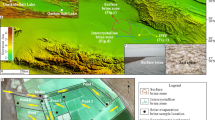Abstract
Ca-chloride waters are defined as those in which Q=rCa/r(SO4+HCO3)>1, rNa/rCl<0.80, rMg/rCa<0.5 and wCl/wBr<286 (r=meq l–1 and w=mg l–1). Throughout the last 50 years, different models for the formation of such waters have been suggested. These models include: (1) filtration through semipermeable membranes under conditions of highly compacted argillaceous sediments, (2) deaquation of seawater by evaporation and/or by freezing followed by dolomitization, (3) hydrolysis of plagioclase and biotites in igneous metamorphic rock masses, (4) radiolytic modification of residual metamorphic fluids, and (5) dissolution of chalks followed by ion exchange on smectites. The better understanding of processes and of natural environments leading to the evolution and natural occurrence of such brines, is imperative for the prospection and further sustained exploitation of such waters.
Similar content being viewed by others
Author information
Authors and Affiliations
Additional information
Received: 11 October 1996 · Accepted: 24 February 1997
Rights and permissions
About this article
Cite this article
Rosenthal, E. Thermomineral waters of Ca-chloride composition: review of diagnostics and of brine evolution. Environmental Geology 32, 245–250 (1997). https://doi.org/10.1007/s002540050213
Issue Date:
DOI: https://doi.org/10.1007/s002540050213




